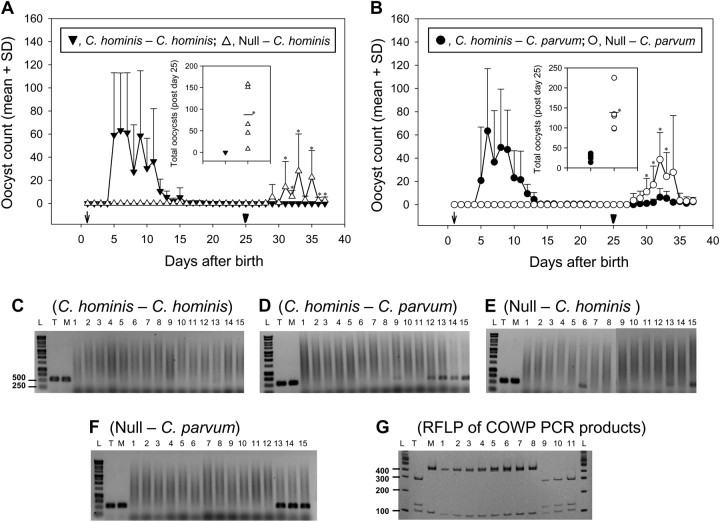Figure 1.
Cross-protection studies in the gnotobiotic piglet model. A, B, Piglets shed oocysts in feces following primary infection (arrows) with Cryptosporidium hominis (C. hominis–C. hominis, A; and C. hominis–Cryptosporidium parvum, B). Piglets that were not subjected to primary infection remained negative until infected (null–C. hominis, A; and null–C. parvum, B). Following challenge infection (arrowheads), piglets of all groups (A and B) except the C. hominis–C. hominis group (A) shed oocysts. The y-axis shows mean + standard deviation (SD) of oocyst count (in 30 microscopic fields at ×100 magnification). The statistically significant differences of oocyst count between the groups on a particular day are shown with asterisks. Insets of figure A and B show scatterplots (means represented by a bar) of total oocyst counts of each piglet during 12 days of postchallenge (days 26–37 after birth) from null–C. hominis/C. hominis–C. hominis groups and null–C. parvum/C. parvum–C. parvum groups, respectively. Statistically significant differences of total oocyst count between groups are indicated with asterisks. C–G, Cryptosporidium oocyst wall protein (COWP) polymerase chain recation (PCR) restriction fragment length polymorphism (RFLP) analysis of intestinal sections from a piglet of each of the 4 infection groups at necropsy 12 days after challenge infection. C–F, PCR analysis of the 15 intestinal sections; lanes 1–12 correspond to sections of the small intestine and lanes 13–15 to the large intestine. G, RFLP results of the 553-bp amplicon digested with RsaI. Lanes T and M are positive controls with C. hominis TU502 and C. parvum MD DNA, respectively. Lane L contains 1-kb ladder (C–F) or 100-bp ladder (G). The experimental group for panels C–F is shown above each figure. G, Lanes 1–5 contain RFLP products of the COWP PCR products of lanes 9 and 12–15 of the C. hominis–C. parvum group, respectively; lanes 6–8 contain COWP PCR-RFLP products of lanes 13–15 of the null–C. parvum group, respectively; and lanes 9–11 contain RFLP products of the COWP PCR products of lanes 6, 13, and 15 of the null–C. hominis group, respectively. Digestion with RsaI yields fragments of 285, 125, 106, and 34 bp for type C. hominis and 410, 106, and 34 bp for C. parvum. The 34-bp fragment is not shown as it runs through the gel.

